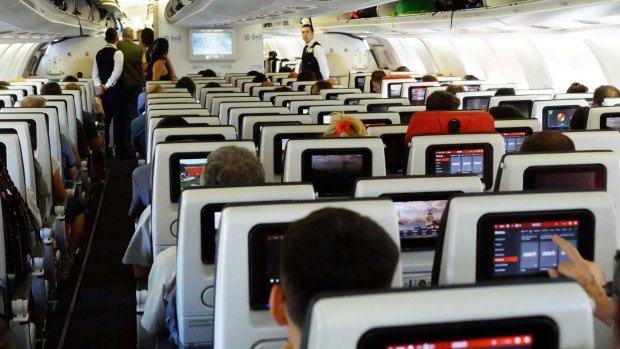This was published 3 years ago
Social distancing on planes during coronavirus: Middle seat won't stay empty for long
By Dawn Gilbertson

Keeping middle seats empty for social distancing is not feasible, the airline industry argues.Credit: iStock
Of all the safety steps airlines are taking to lure travellers back onto their planes in the coronvirus era, the empty middle seat is the most alluring.
What passenger in an aisle or window seat hasn't wished or even prayed that the person heading down the aisle is not bound for the unoccupied seat next to them?
Qantas, Virgin Australia and many other carriers are granting that wish in the name of social distancing by blocking middle seat assignments and/or not filling planes to capacity to assure passengers it's safe to fly.
But passengers shouldn't get too giddy about the extra space, experts and some airline executives say, because it won't last forever.
"It's a lovely soundbite," said John Grant, senior aviation analyst with aviation analytics firm OAG. "It's just not practical."
He says the social distancing measures will be temporary.
It all comes down to money. Airlines make money when they fill a certain percentage of seats, and leaving middle seats empty means they'll have to charge more for the remaining seats.
The figure for low-cost carriers including Southwest and JetBlue, according to OAG: 52 per cent more per passenger on average.
The International Air Transport Association, which has come out strongly against permanent social distancing on planes because it says the risk of virus transmission is low and the new mask requirements will provide more passenger protection, says average fares would jump 43 per cent to 54 per cent around the world depending on the region.
In North America, filling just two-thirds of the plane by keeping middle seats empty would boost the average ticket price by 43 per cent, from $202 to $289, based on 2019 figures, IATA says. Airlines in the region need to fill three-fourths of their seats to break even, the group says.
Most travellers won't be willing to pay the price, critics and skeptics of permanent social distancing say. Leisure travellers, the passengers the industry expects to return first when travel demand comes back, are notoriously price sensitive and lured by cheap fares.
"Airlines are fighting for their survival. Eliminating the middle seat will raise costs," IATA general director and CEO Alexandre de Juniac said in a statement. "If that can be offset with higher fares, the era of affordable travel will come to an end. On the other hand, if airlines can't recoup the costs in higher fares, airlines will go bust."
Southwest Airlines CEO Gary Kelly said he views social distancing on planes, among other new passenger safety steps including masks, as a temporary measure until the pandemic is over.
"I'm not willing to accept yet that the flight experience is forevermore changed," he told Wall Street analysts and reporters in late April.
He said spacing travellers out on planes can't last forever because airlines would lose even more money than they are already losing.
"We've got to have some balance between social distancing and just the affordability for people to fly," he said.
Grant said he expected some airlines to offer empty middle seats for a fee, as Frontier Airlines proposed this week but quickly withdrew due to criticism that it was profiteering. But he said that practice, too, will fade when travel demand returns because the airline could get more by selling another ticket than it could from the fees paid by the passenger in the window or aisle seat.
Leaving middle seats open is not hurting airlines at the moment, of course, because the coronavirus crisis and stay-at-home orders have decimated demand. U.S. airlines have parked 49 per cent of their planes, according to the trade group Airlines for America, and the planes still flying are seeing an average 17 passengers per day, compared with 85 to 100 earlier this year before the crisis hit. United executives last week said pilots outnumber passengers on some flights.
"Right now that is obviously an easier thing to do," Hawaiian Airlines CEO Peter Ingram said of middle seat blocking on the airline's earnings call this week.
Longer term, he said, some of the social distancing measures in place now are "not particularly sustainable."
Airlines have to fly pretty full for the industry to make money unless they push fares "way, way up."
"That math works for Hawaiian Airlines. That math works for every airline that we compete with."
USA Today
See also: New coronavirus hygiene rules could send airfares sky-high
Sign up for the Traveller newsletter
The latest travel news, tips and inspiration delivered to your inbox. Sign up now.